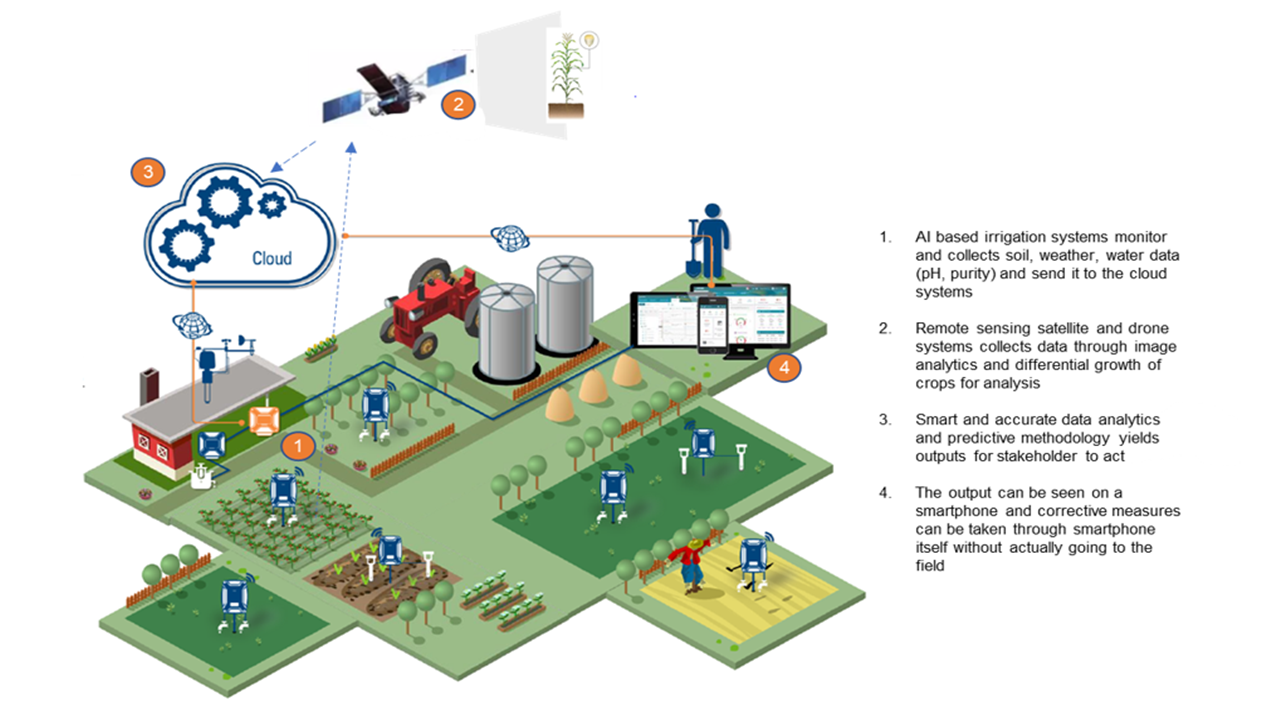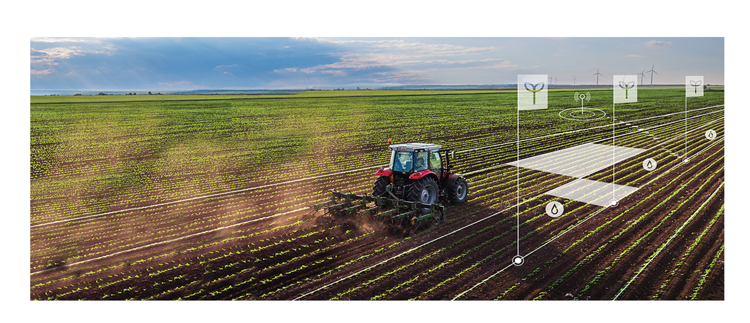The Agricultural Revolution- Beyond Precision
By 2030, around 600 million people in India will face minimal food availability with the current rate of agricultural productivity growth. To counter this problem, it needs an exponentially developing technology like Artificial Intelligence to bridge the gap and deliver sustainable results. Artificial intelligence (AI) is a technology of low-cost prediction and discovery. It exploits the new resource of the digital age to identify patterns and make predictions. In countries like India that lack required human capital in fields like agricultural science and lower coverage of adequate information, AI presents a vast opportunity for companies to leverage the solutions and deliver better results for the farmers.
Mangesh is sipping morning tea in his home in Maharashtra’s sugarcane belt while a farm instrument installed on the field is cognizant of the soil moisture, weather trends, and recent rainfall and gives consistent data on his smartphone. Mangesh just opened his phone, checks the data and feeds a new irrigation schedule and moved on. A satellite is taking images of Mangesh’s crops for pest prediction and yield estimation and feeds the data back to Mangesh, input companies, prospective buyers, credit organizations and relevant stakeholders. For many, this may still seem to be a scene from a science fiction movie set in 2050 and not something that in reality is happening in 2019. This is the effect of digitalization combined with artificial intelligence.

AI, not just Artificial but Advanced Intelligence
In the 1990s, India, an average farmer took a decision on farming, irrigation and pest control based on available resources and limited observable data. In just 20 years, the average farmer is now moving towards effective products and resources to get more productivity from the similar or even lesser available resources and wealth of data to make informed decisions. It is often said that "Data is the new oil of the economy" and the same has been helping in agricultural transformation across the world.
Artificial intelligence (AI) is a technology of low-cost prediction and discovery. It exploits the new resource of the digital age (the precious data) to identify patterns and make predictions. In countries like India that lack required human capital in fields like agricultural science and lower coverage of adequate information, AI presents an opportunity to bridge the gap and deliver sustainable results.
Bringing the confidence in uncertainty
Newest AI-led applications and technologies are disrupting the agricultural space every day and creating a platform for better preventive measures, yield productivity, and resource utilization. We can categorize the current applications based on the solutions into four major categories.
In Crop and soil monitoring segment; image analytics, soil variability measurement, deep learning algorithms are being leveraged by companies for processing captured data and offering accurate solutions in a relatively short period. The Automated Irrigation segment has shown disruptive advancements by enabling AI and data-driven automated irrigation, fertilizer application with irrigation (Fertigation) and crop protection. Innovative products capable of monitoring, analyzing, and controlling the irrigation backed by AI have already been introduced in the market with the consistent addition of advanced features. With irrigation as the most important input to any crop and 70% of the world’s freshwater used for agriculture, the ability to better manage how it’s used will also have a huge impact on the world’s water supply and not just limited to agriculture.
Predictive analytics cover an entire solution range that made guesses about the future of farming, not a magic dependent, but a data science-based one. Infield sensors, remote sensing inputs, and several data points help to take a well-informed decision much easier. Machine learning models and algorithms based on past and present factors in the field, along with environmental factors help to make an accurate prediction of each step of farming.
Agricultural Robotics segment backed by sturdy hardware and software alignment is currently used and proponents of the robotics market are developing and programming offerings that are equipped with the intelligence to handle essential agricultural tasks and operate in unstructured and dynamic agricultural environments.
Precision farming and AI a necessity
A Global Harvest Initiative report pointed out that at the current rate of agricultural productivity growth in India, domestic production will only meet 59 per cent of the country's food demand by 2030. That means around 600 million people will be dependent on imports or will face minimal food availability. The variability in farming due to external factors is on an exponential increase with the change in weather patterns, rainfall variability, new pest attacks. It needs an exponentially developing technology like AI to counter the effects and led to a sustainable environment of growth and productivity improvement in agriculture. Food and water two of the most important constituents of earth sustainable life is under severe stress – World need to double our food production by 2050 to match the population growth and 20% of the world population faces water shortages today as per the UN report (India is under severe water stress category). With depleting resources in terms of arable land and available water, precision farming and AI usage are a necessity and not a luxury.
The ageing farming population is also presenting a grave challenge for continued efficiency in the farmlands. In the USA, the average age of farmers was 58.4 years according to the survey. India, China and other countries are already at crossroads with more ageing farmers and lack of youth interest in agriculture. Technological intervention is required to increase the efficiency of ageing agricultural production and pulls the younger generation to agriculture.
The Way Present and the Forward
In his famed book “The Innovator’s Dilemma”, Claydon Christensen wrote that “Disruptive technology should be framed as a marketing challenge, not a technological one”. The same is currently true for the agricultural space where the immense benefits of the new technology are ever evident backed by strong research and data (a shift from general irrigation to precision irrigation or an on-time pest control measure through image-capturing), it is the marketing disruption that is the challenge for extensive adoption. Any technology standing on the 4 pillars of being insightful, actionable, simple to use and value-creating one will lead to easier adoption in the agriculture space.
With precision farming and AI becoming more important than ever for the sustenance of agricultural growth, there is a vast opportunity for companies to leverage the solutions and deliver better results for the farmers. Established companies both in agriculture and technology space and the rise of new startups are fuelling up with this growth and the future looks greener with more innovation. Mangesh added, "We used to farm with available resources and hard work. Fewer resources mean less production. Now adopting “smart” technologies helped us to grow much more with lesser resources, efforts, water, and fertilizers”.
This article is published in Siliconindia magazine, May 2019 edition.

COMMENTS
We'd love to hear your thoughts! To enter a comment, type your name and email address.